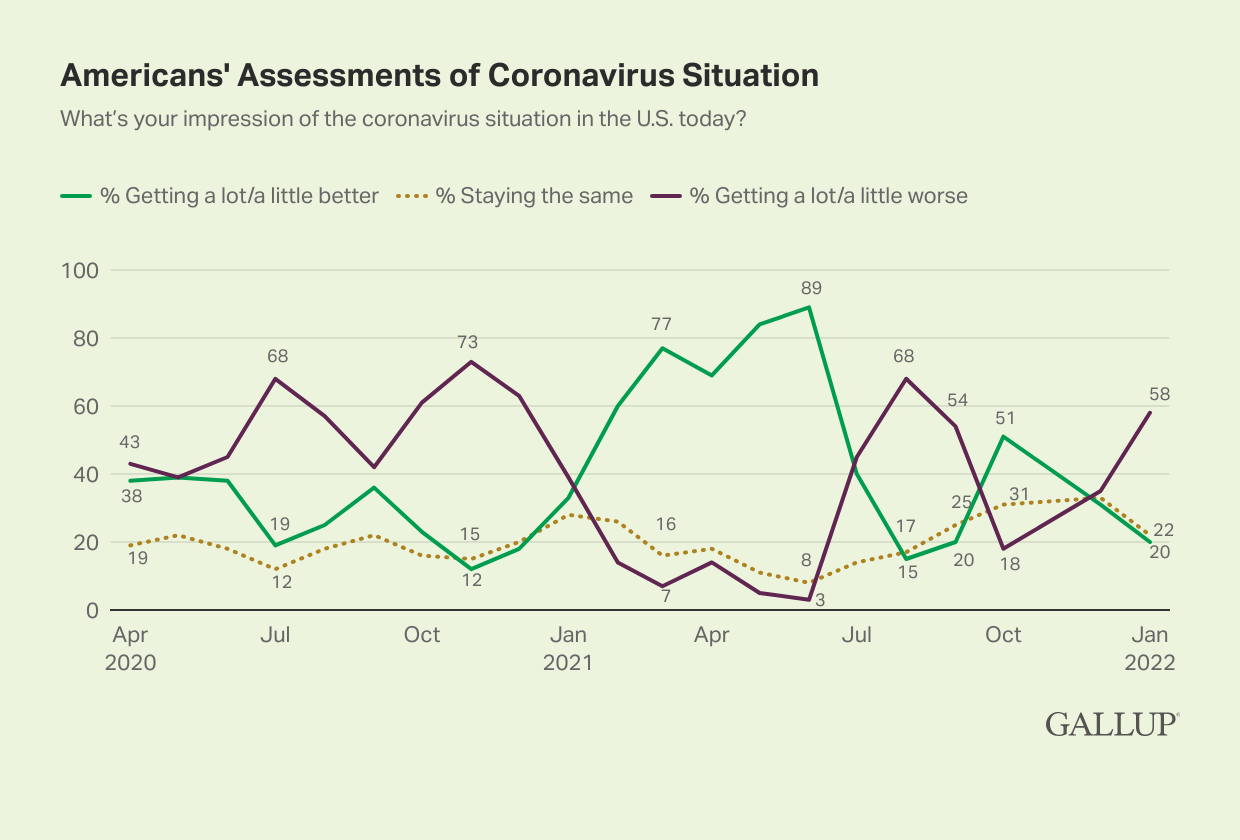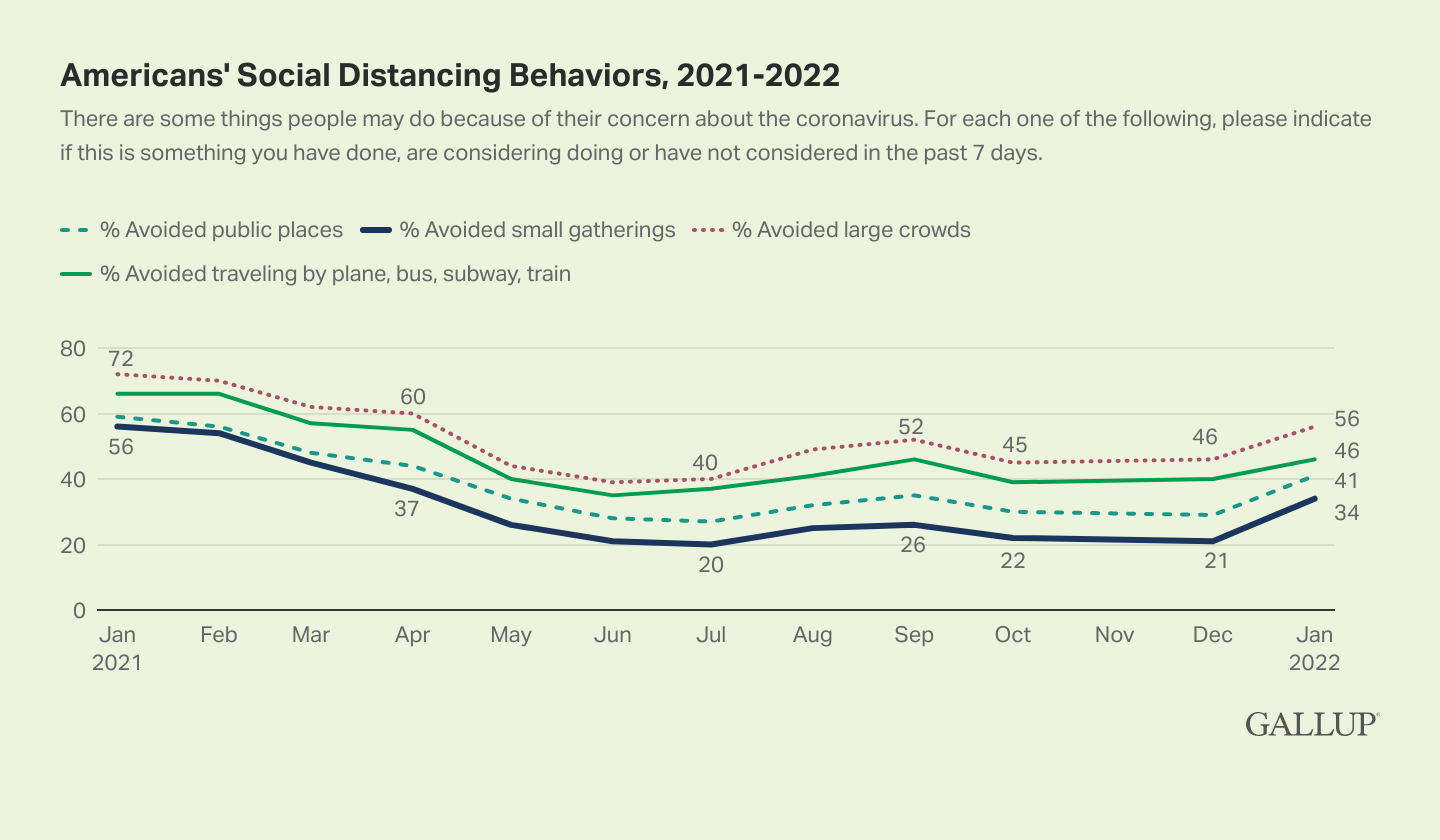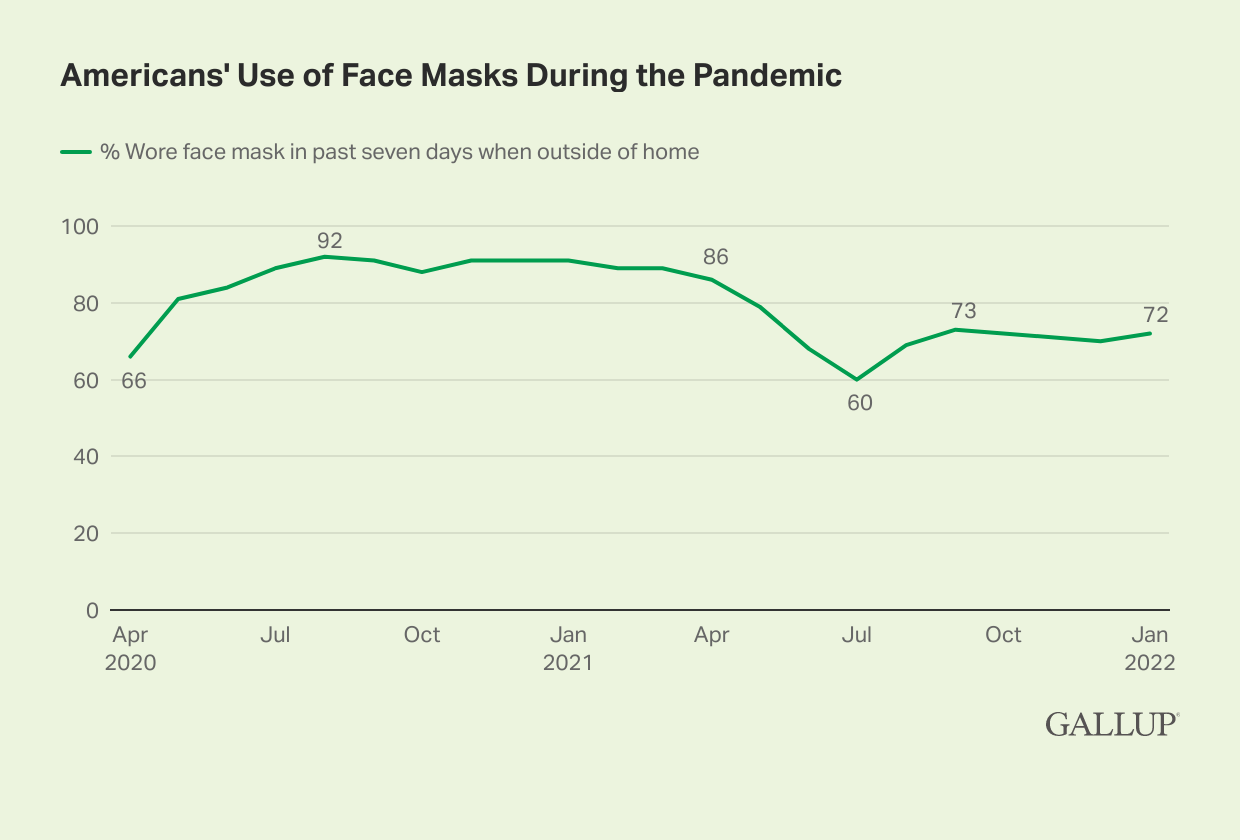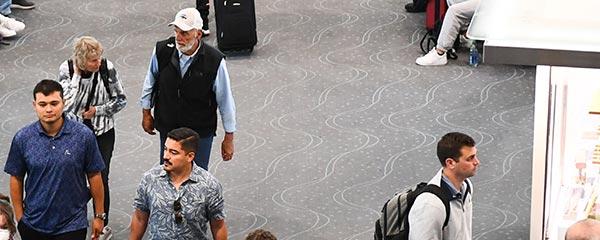Story Highlights
- 20% think pandemic is improving, 22% staying same, 58% getting worse
- 50% are worried about contracting COVID-19; up 12 points since late November
- Social distancing behaviors on the rise; 72% continue to wear mask in public
WASHINGTON, D.C. -- With the highly transmissible omicron variant of COVID-19 infecting hundreds of thousands of Americans daily, optimism about the trajectory of the pandemic in the U.S. has fallen sharply, and worry about contracting the virus has risen to its highest level in a year. The latest update to Gallup's COVID-19 data, from a survey conducted Jan. 3-14, finds U.S. adults' social distancing behaviors have picked up, and the use of masks in public remains high.
Views of Pandemic Now Sharply Negative
The hopefulness Americans felt last spring after the rollout of the COVID-19 vaccines was first dashed over the summer by the delta variant, then recovered briefly as cases subsided, and is now being crushed by omicron.
In May and June 2021, as increasing numbers of Americans were vaccinated against COVID-19, more than four in five U.S. adults believed the coronavirus situation was getting better. Yet, as the delta variant began to emerge and spread in July, that figure plummeted to 15%.
By October, with infections from the delta variant waning, a slim 51% majority once again thought the situation was improving. However, as news of the omicron strain's emergence in Africa began to circulate in November, Americans became more concerned, and the percentage saying the situation was improving fell 20 percentage points. The latest reading is down an additional 11 points.
Along with the 20% of U.S. adults who currently say the pandemic is improving, 22% think it is staying the same and 58% believe it is worsening.

Line graph. Percentages of Americans who think the coronavirus situation in the U.S. is getting a lot or a little better, staying the same, or getting a lot or a little worse, from April 2020 to January 2022. Currently, 20% of U.S. adults say the situation is getting better, down from 51% in October. Twenty-two percent say it is staying the same, and 58% say it is getting worse.
Worry About Getting COVID-19 Highest Since Last Winter
As was the case last July, when delta infections began to surge, Americans' worry about contracting the virus is now on the rise. Worry has jumped 12 points to 50% since the previous reading in late November/early December and is now the highest it has been since last winter, before COVID-19 vaccines were readily available to the general public.

Line graph. Monthly trend from April 2020 to January 2022, showing the percentage of Americans who are very or somewhat worried that they will get the coronavirus. This percentage was steady near 55% throughout 2020. It then dipped to 35% in March 2021 and 17% in June before rising in August. It has risen 12 points to 50% since late November/early December.
Although levels of worry about getting COVID-19 remain different among various demographic groups, concern has increased across most of them since late November/early December. Worry has increased by double digits among all age groups, with the greatest jump among older Americans. Worry among Democrats, independents and those who are vaccinated against the disease has also risen by double digits. Concern among Republicans and unvaccinated adults has increased less, and they remain among the least worried about infection.
| Nov/Dec 2021 | Jan 2022 | Change | |
|---|---|---|---|
| % | % | pct. pts. | |
| Age group | |||
| 18-34 years old | 47 | 57 | +10 |
| 35-54 years old | 38 | 48 | +10 |
| 55 and older | 29 | 46 | +17 |
| Party identification | |||
| Democrat | 53 | 71 | +18 |
| Independent | 35 | 46 | +11 |
| Republican | 19 | 27 | +8 |
| Vaccination status | |||
| Vaccinated against COVID-19 | 44 | 59 | +15 |
| Unvaccinated/Unwilling to be | 11 | 16 | +5 |
| Gallup | |||
When worry about contracting COVID-19 last spiked during the delta variant surge, Gallup found a concurrent rise in the percentage of Americans saying they had gotten vaccinated. Such an increase in vaccinations has not been seen in the latest data.
Increase in Social Distancing Behaviors
Throughout the pandemic, increased worry about contracting COVID-19 has resulted in an uptick in Americans' social distancing behaviors. With the recent sharp rise in U.S. COVID-19 cases, more Americans now report avoiding situations that might expose them to the virus.
Specifically, 56% of U.S. adults say they avoided large crowds in the past week because of their concern about the coronavirus. Likewise, 46% did not travel by plane, bus, subway or train, and 41% are staying away from public places such as stores and restaurants. Fewer, 34%, say they have eschewed small gatherings. The latest increases in avoidance of small gatherings (+13 points), public places (+12), and large crowds (+10) are larger than for travel (+6).

Line graph. Monthly trend from January 2021 to January 2022 for the percentages of Americans avoiding certain behaviors due to the coronavirus. In January 2022, 56% are avoiding large crowds, 46% are avoiding traveling, 41% are avoiding public places and 34% are avoiding small gatherings. The percentage avoiding each has risen since last month as the omicron variant has surged.
Another activity that Americans have curtailed recently is indoor dining at restaurants. Since May 2020, no more than 30% of U.S. adults have reported dining inside a restaurant in the previous 24 hours. The latest 18% who say they have done so is down from 24% in late November/early December, but it is slightly higher than one year ago.

Line graph. The percentage of Americans who say they have dined indoors in a restaurant in the past 24 hours from January 2021 to January 2022. The latest 18% marks a decline from December's 24% reading. In June and July, a high of 30% said they had dined inside a restaurant.
U.S. adults who are worried about catching COVID-19 are far less likely than those who are not worried to have done each of these activities. Although Americans who are vaccinated against COVID-19 are more protected against infection and serious illness than those who are not vaccinated, they are also more likely to avoid each of these activities.
Face Mask Use in Public Remains Steady
While greater concern about the virus may be causing more Americans to avoid public situations, the use of face masks in public is unchanged in recent months. Since August, roughly seven in 10 U.S. adults, including 72% in the new survey, say they have worn face masks when out in public in the past seven days. Since mid-April 2020, no fewer than six in 10 Americans have done so, including more than nine in 10 in the summer of 2020, when many businesses were requiring face coverings.

Line graph. Percentage of Americans who say they have worn a mask in the past seven days when outside their homes, trend since April 2020. The current 72% has been roughly steady since August. It peaked at 92% in August 2020.
Americans' use of masks in public continues to diverge sharply based on several factors. Those who are concerned about contracting COVID-19 are more likely to use a mask than those who are not concerned. Majorities of Democrats and independents continue to say they wore a mask in the past week, while less than half of Republicans have. U.S. adults who have been vaccinated against COVID-19 are more than twice as likely as those who have not to report that they wore a mask in public in recent days.
| Have worn mask in past 7 days | |
|---|---|
| % | |
| Worried about getting COVID-19 | |
| Very worried | 93 |
| Somewhat worried | 90 |
| Not too worried | 67 |
| Not at all worried | 32 |
| Party identification | |
| Democrat | 94 |
| Independent | 65 |
| Republican | 48 |
| Vaccination status | |
| Vaccinated against COVID-19 | 82 |
| Unvaccinated/Unwilling to be | 31 |
| Gallup, Jan. 3-14, 2022 | |
Bottom Line
When the COVID-19 vaccine was rolled out last year, there was great hope that the pandemic would have ended in the U.S. by now. But with COVID-19 cases in the U.S. skyrocketing due to the omicron variant of the virus, Americans' views of the pandemic have once again turned negative, and worry about getting the virus is on the rise to levels not seen since vaccines were widely available. As the public tries to cope with the fallout of this new variant, many have reverted to social distancing behaviors last employed when the pandemic was at its worst.
Views of the pandemic remain sharply politically polarized, and the steady share of about one-fifth of the adult population that is not vaccinated against COVID-19 is largely eschewing masks and social distancing measures. Meanwhile, public health officials continue to promote the use of masks and the benefits of vaccines as the way to end the pandemic.
To stay up to date with the latest Gallup News insights and updates, follow us on Twitter.
Learn more about how the Gallup Panel works.



